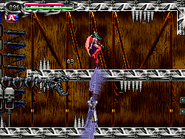- For the music, see The Abyss (music).
The Abyss is a location and the ending stage of Castlevania: Dawn of Sorrow.
Overview[]
Based on the Abyss of Hell, this is the last area in the game, with some of the hardest enemies/enemy combinations in the game (Stolas, who constantly summons Erinyes and Flame Demons, are a great danger in small rooms, for example). When all areas of The Abyss are linked, a hexagram-like shape is formed on the map, each of its sections do not look connected at any point. However, due to the chaotic nature of this location, it inexplicably teleports the player from one sector to another.
Each of its sections represents six separated "hells":
- A typical fire and brimstone landscape complete with fire pillars that shoot up from the ground at timed intervals. The sole Arc Demon of the game can be found here.
- A strange quicksand-like pit with oddly placed ear structures with said sand running out of them. The Hippogryph soul can be acquired here.
- An icy and misty aura place filled with Malachis and Frozen Shades.
- A blood red aura area (almost looking like a gastric organ) with moving shadows of tortured beings seen in the background. Abaddon, the master of locusts and boss of the area, can be fought in this section.
- An outer space area (complete with aurora) filled with Stolases and Black Panthers.
- And finally, a spike ridden lair with elaborate insectoid designs embedded within its walls.
The final section resides within the exact center of the location, of which its environment is more twisted than any of the surrounding sections. It is here that the final battle ensues (in Julius Mode, the final section of the Abyss is an edited version of the throne room from The Pinnacle).
It should be noted that all sections (save for the top-right section) of this area have six rooms each. The northeast section has an extra room needed to warp to the center of the area to fight Menace. With the addition of Menace's room, the count reaches 38; however, it should also be noted that this room does not appear on the map and does not count toward the exploration rate counter on the menu screen.
In Normal Mode, Soma meets Dmitrii in the center of the Abyss through the portal, where he has sealed Arikado's power by killing Celia. He tries using the copied form of Soma's Power of Dominance, although being a mere copy he is unable to control it and a demon known as Menace bursts out of him. The player beats the game and is presented with the ending once they have defeated this abomination.
In Julius Mode, the warp room takes the player back to an edited version of the Pinnacle's throne room, where Julius, Yoko and Alucard fight Soma as the Dark Lord.
Gallery[]
Screenshots[]
Map[]
Trivia[]
- If all the points were connected, with the warp room placed over the castle map's location of this room, the Abyss would overlap with the warp room of the Silenced Ruins.
- In Castlevania: Curse of Darkness, Dracula mentions this place as the place his soul goes after he's defeated. Both this game and Dawn of Sorrow were released the same year, so it's possible that it's a reference.
- The area takes on a semblance similar to Hell as described in the Holy Bible. The second term for "Abyss" also refers to when a video game character (player, NPC or enemy) falls into a pit or black hole that's neverending.
- In addition, the fact that Abaddon is the boss of this area could be a reference to the entity of the same name in the Christian Bible's Book of Revelation.
- Some sections seem to be directly inspired by the Circles of Hell depicted in the Divine Comedy:
- The sandy area could be a reference to the third ring of the Seventh Circle, where blasphemers are punished.
- The frozen area could be a reference to the Ninth and last Circle, where traitors are punished and where Satan was banished, trapped up to his waist in a frozen lake.
- The organic area could be a reference to the Third Circle, where the gluttonous are punished.
- The presence of the demon Malacoda, also from the Divine Comedy, reinforces the resemblance between the poem's Hell and the game's.
- The six triangular sections in which the Abyss is arranged might also have been inspired by Buddhist lore. Buddhist cosmology typically identifies six realms of rebirth and existence: gods, demigods, humans, animals, hungry ghosts, and hells for evil karma.
See also[]
External links[]
- IGN Guide - Source of the castle map.
- Castlevania Realm - Source of the images.
| Castlevania: Dawn of Sorrow |
|---|
| Characters |
| Protagonists |
| Soma Cruz • Mina Hakuba • Julius Belmont • Yoko Belnades • Genya Arikado (Alucard) • Hammer |
| Antagonists |
| Celia Fortner • Dario Bossi • Dmitrii Blinov • Soma Cruz (Julius Mode) |
| Bosses |
| Flying Armor • Balore • Malphas • Puppet Master • Rahab • Gergoth • Zephyr • Bat Company Paranoia • Aguni • Abaddon • Death • Menace |
| Areas |
| The Lost Village • Wizardry Lab • Garden of Madness • The Dark Chapel • Demon Guest House • Condemned Tower Cursed Clock Tower • Subterranean Hell • Silenced Ruins • The Pinnacle • Mine of Judgment • The Abyss |
| Music |
| Castlevania: Aria of Sorrow & Castlevania: Dawn of Sorrow Original Soundtrack |
| Guides |
| Castlevania: Dawn of Sorrow - The Official Strategy Guide Konami Akumajō Dracula: Sōgetsu no Jūjika Official Guide |
| Archives |
| Bestiary • Inventory • Julius Mode • Voice Translations |





